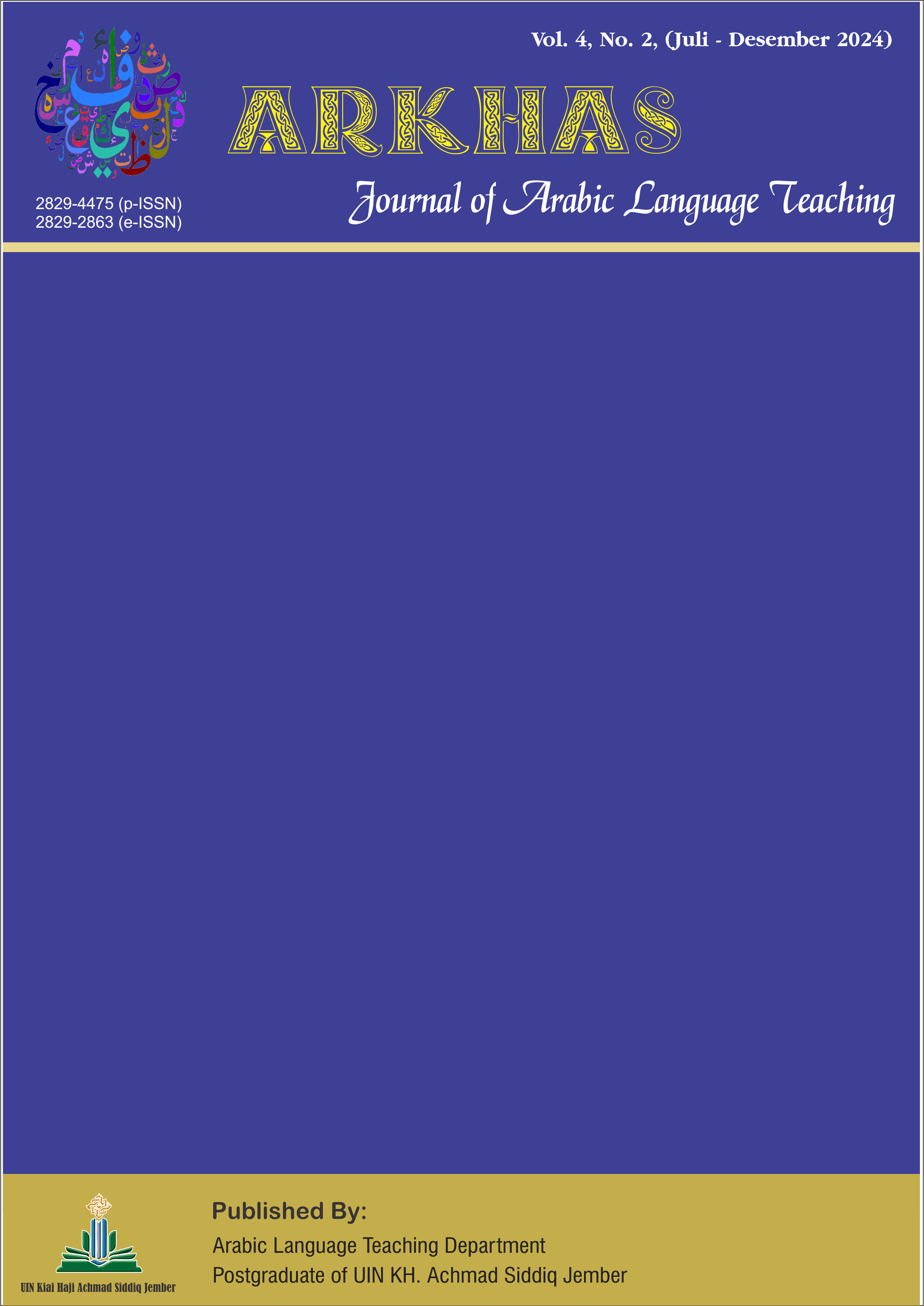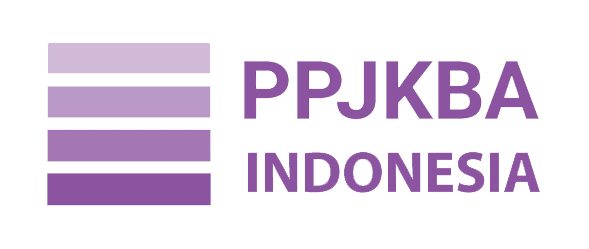Evolving Speaking Strategies in Arabic Learning: Insights from Oxford’s Strategy Inventory in Indonesia
DOI:
https://doi.org/10.35719/arkhas.v5i2.2381Keywords:
Arabic Language Learning Stretagies, Maharah Kalam, Rebecca Oxford, Strategi Belajar BahasaAbstract
This study aims to examine the learning strategies used by students of the Arabic Language Education Study Program, Faculty of Tarbiyah, State Islamic Institute of Kediri in the maharah kalam course using the language learning strategy classification verified by Rebecca Oxford. The results of this study can provide an overview for language learners, teachers, and practitioners about the learning strategies that are widely used in learning maharah kalam. This study employs a mixed-method approach with a sequential explanatory design. Quantitative data were collected through a questionnaire adapted from the Strategy Inventory for Language Learning (SILL), while qualitative data were gathered through in-depth interviews with selected respondents to explore the concrete forms of learning strategies employed. The results of the study indicate that students use various learning strategies, both direct (such as cognitive and compensatory strategies) and indirect (such as metacognitive and social strategies). Metacognitive strategies, such as planning and self-evaluation, and social strategies, such as collaborating with friends, are the most dominant strategies used. The researcher also found a lack of understanding and application of affective strategies among students, which impacts their low self-confidence in speaking Arabic in public.
Penelitian ini bertujuan untuk menelaah strategi pembelajaran yang digunakan oleh mahasiswa Program Studi Pendidikan Bahasa Arab, Fakultas Tarbiyah, Institut Agama Islam Negeri Kediri dalam mata kuliah maharah kalam dengan menggunakan klasifikasi strategi pembelajaran bahasa yang dikembangkan oleh Rebecca Oxford. Hasil penelitian ini diharapkan dapat memberikan gambaran bagi para pembelajar bahasa, pendidik, dan praktisi mengenai strategi pembelajaran yang paling banyak digunakan dalam pembelajaran maharah kalam. Penelitian ini menggunakan pendekatan campuran (mixed method) dengan desain penjelasan berurutan (sequential explanatory design). Data kuantitatif dikumpulkan melalui angket yang diadaptasi dari Strategy Inventory for Language Learning (SILL), sedangkan data kualitatif diperoleh melalui wawancara mendalam dengan responden terpilih untuk menggali bentuk konkret penerapan strategi pembelajaran yang digunakan. Hasil penelitian menunjukkan bahwa mahasiswa menggunakan berbagai strategi pembelajaran, baik strategi langsung (seperti strategi kognitif dan kompensasi) maupun strategi tidak langsung (seperti strategi metakognitif dan sosial). Strategi metakognitif, seperti perencanaan dan evaluasi diri, serta strategi sosial, seperti kerja sama dengan teman, merupakan strategi yang paling dominan digunakan. Peneliti juga menemukan kurangnya pemahaman dan penerapan strategi afektif di kalangan mahasiswa, yang berdampak pada rendahnya kepercayaan diri mereka dalam berbicara bahasa Arab di depan umum.
References
Afyuddin, M. S., & Maarif, M. S. (2023). Listening Learning Strategy Used by Arabic Education Students. Al-Irfan : Journal of Arabic Literature and Islamic Studies, 6(1), 138–166. https://doi.org/10.58223/alirfan.v6i1.6617
Afyuddin, M. S., Muslimah, M., Kholis, M. N., & Rahmawati, R. D. (2023). Development of Tadris Al- ’ Arabiyyah Al-Mukatssaf (TAM) Textbook , Based on Contextual Teaching and Learning (CTL). 7(1), 1–17. https://doi.org/10.30762/asalibuna.v7i01.1084
Alhaisoni, E., & Alhaysony, M. (2017). An Investigation of Saudi EFL University Students’ Attitudes towards the Use of Google Translate. International Journal of English Language Education, 5(1), 72. https://doi.org/10.5296/ijele.v5i1.10696
Ayodele, T. A. (2020). Determining the domain of postproverbials in human language development theories and stages. Matatu, 51(2), 448–461. https://doi.org/10.1163/18757421-05102016
Chamot, A. U. (2004). Issues in Language Learning Strategy Research and Teaching. Electronic Journal of Foreign Language Teaching, 1(1), 14–26. https://doi.org/10.1017/S0261444808005612
Chan, M.-L. (2012). Personality Type, Perceptual Style Preferences and Strategies for Learning English as Foreign Language, Social Behavior and Personality. Social and Personalty Research. https://doi.org/http://dx.doi.org/10224/sbp.2012.40.9.1501.
Chen, J. (2022). The effectiveness of self-regulated learning (SRL) interventions on L2 learning achievement, strategy employment and self-efficacy: A meta-analytic study. Frontiers in Psychology, 13. https://doi.org/10.3389/fpsyg.2022.1021101
Creswell, J. W., & Creswell, J. D. (2018). Research Design Qualitative, Quantitative, and Mixed Methods Approaches (Fifth Edit). SAGE Publication, Inc.
DeKeyser, R. M. (2010). Practice in a Second Language Perspectives from Applied Linguistics and Cognitive Psychology. Cambridge University Press. https://doi.org/https://doi.org/10.1017/CBO9780511667275
Ellis, R. (2015). Understanding Second Language Acquisition (Second Edi). Oxford University Press.
Fasikhah, S. S., & Fatimah, S. (2013). Self-Regulated Learning (Srl) Dalam Meningkatkan Prestasi Akademik Pada Mahasiswa. Jurnal Ilmiah Psikologi Terapan, 01(01), 145–155.
Hakim, T. L., Haris, A., & Huda, M. M. (2025). Assessment of Speaking Skills (Maharah Kalam) in Arabic Language Lesson at Madrasah Ibtidaiyah Riyadlus Sholihien Jember. Journal of Science and Education (JSE), 5(2), 599–605. https://doi.org/10.58905/jse.v5i2.485
Iskandarwassid, & Sunendar, D. (2011). Strategi Pembelajaran Bahasa. PT. Ramaja Rosdakarya.
Jauharoh, E., Anam, W., & Huda, M. M. (2021). The Use of Expressions in Improving Kalam Skill in Learning Arabic for MTSN 2 Kediri Students. Asalibuna, 5(02), 53–61. https://doi.org/10.30762/asalibuna.v5i02.586
Miles, M. B., & Huberman, A. M. (2014). Qualitative data analysis: A methods sourcebook (J. Saldana (ed.); 3rd ed.). SAGE Publication.
Morris, M. W., Savani, K., & Fincher, K. (2019). Metacognition fosters cultural learning: Evidence from individual differences and situational prompts. Journal of Personality and Social Psychology, 116(1), 46–68. https://doi.org/10.1037/pspi0000149
Nation, I. S. P. (2013). Learning vocabulary in another language. Learning Vocabulary in Another Language, 1–624. https://doi.org/10.1016/s0889-4906(02)00014-5
Oxford, R. L. (2016). Teaching and Researching Language Learning Strategies (1st Editio). Routledge. https://doi.org/https://doi.org/10.4324/9781315719146
Pawlak, M., Kruk, M., Zawodniak, J., & Pasikowski, S. (2022). Examining the underlying structure of after-class boredom experienced by English majors. System, 106, 102769. https://doi.org/10.1016/j.system.2022.102769
Pranatawijaya, V. H., Widiatry, W., Priskila, R., & Putra, P. B. A. A. (2019). Penerapan Skala Likert dan Skala Dikotomi Pada Kuesioner Online. Jurnal Sains Dan Informatika, 5(2), 128–137. https://doi.org/10.34128/jsi.v5i2.185
Rahimi, M., & Katal, M. (2012). Metacognitive listening strategies awareness in learning english as aforeign language: A comparison between university and high-school students. Procedia - Social and Behavioral Sciences, 31(2011), 82–89. https://doi.org/10.1016/j.sbspro.2011.12.020
Rescher, N. (2017). Pragmatism: The restoration of its scientific roots. Pragmatism: The Restoration of Its Scientific Roots, 684, 1–313. https://doi.org/10.4324/9781315127217
Rosdiana, I., & Taufiqulloh, T. (2025). EXPLORING UNDERGRADUATE STUDENTS’ PERCEPTIONS OF EFL SPEAKING CLASSES: INSIGHTS FROM SIX DIMENSIONS IN INDONESIAN HIGHER EDUCATION. English Review: Journal of English Education, 13(1), 17–28. https://doi.org/10.25134/erjee.v13i1.11248
Siti Soleha, Evi Muzaiyidah Bukhori, & Mokhammad Miftakhul Huda. (2025). Transforming Student’s Arabic Writing Skills through Word Square Media: Examining its Effectiveness. Asalibuna, 8(02), 89–107. https://doi.org/10.30762/asalibuna.v8i02.5231
Sugiyono. (2017). Metode Penelitian Kombinasi (Mixed Method). Alfabeta.
Sweller, J. (1988). Cognitive load during problem solving: Effects on learning. Cognitive Science, 12, 257–285. https://doi.org/https://doi.org/10.1207/s15516709cog1202_4
Torres, G. (2013). Empowering The Language Learner: Language Learning Strategy Training And Self-Regulation In An EFL Classroom. Journal of International Education Research (JIER), 9(3), 267–276. https://doi.org/10.19030/jier.v9i3.7893
Umamah, A., & Cahyono, B. Y. (2020). Indonesian university students’ self-regulated writing (SRW) strategies in writing expository essays. Indonesian Journal of Applied Linguistics, 10(1), 25–35. https://doi.org/10.17509/ijal.v10i1.24958
Vandergrift, L. (1997). The comprehension strategies of second language (French) listeners: A descriptive study. Foreign Language Annals, 30(3), 387–409. https://doi.org/10.1111/j.1944-9720.1997.tb02362.x
Vandergrift, L., & Tafaghodtari, M. H. (2010). Teaching L2 Learners How to Listen Does Make a Difference: An Empirical Study. Language Learning, 60(2), 470–497. https://doi.org/10.1111/j.1467-9922.2009.00559.x
Vygotsky, L. S., Cole, M., Jolm-Steiner, V., Scribner, S., & Souberman, E. (1978). Mind in Society: Development of Higher Psychological Processes. Harvard University Press. https://doi.org/https://doi.org/10.2307/j.ctvjf9vz4
Zunairoh, Y. (2023). The Effect of Cognitive and Metacognitive Learning Strategies in Maharah Qiraah based on Oxford’s Strategy Inventory for Language on Students’ Learning Outcomes. In Arabiyatuna: Jurnal Bahasa Arab (Vol. 7, Issue 1, p. 257). STAIN Curup. https://doi.org/10.29240/jba.v7i1.6530
Downloads
Published
How to Cite
Issue
Section
License
Copyright (c) 2025 Moh. Sholeh Afyuddin, Eka Nur Isnayny Syifa’i Qulub, Isy Firrohmah Al Izzah, Maziyyatul Muslimah

This work is licensed under a Creative Commons Attribution 4.0 International License.












